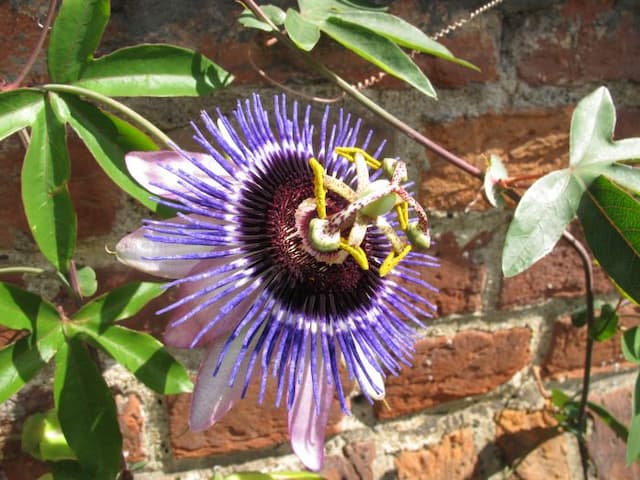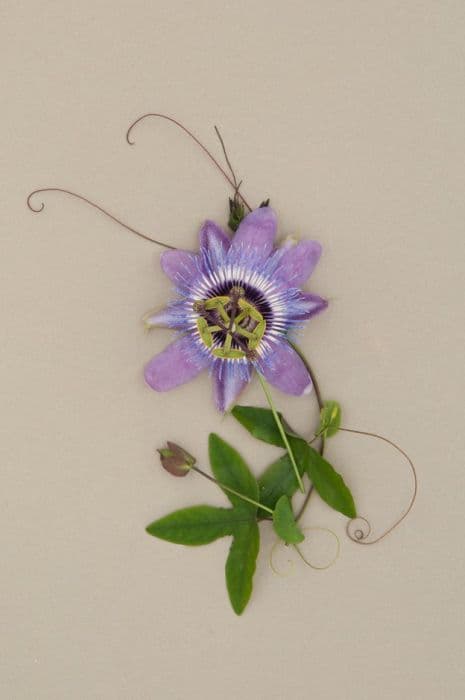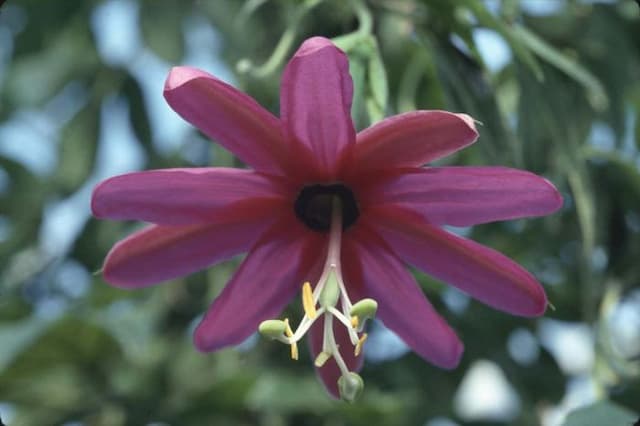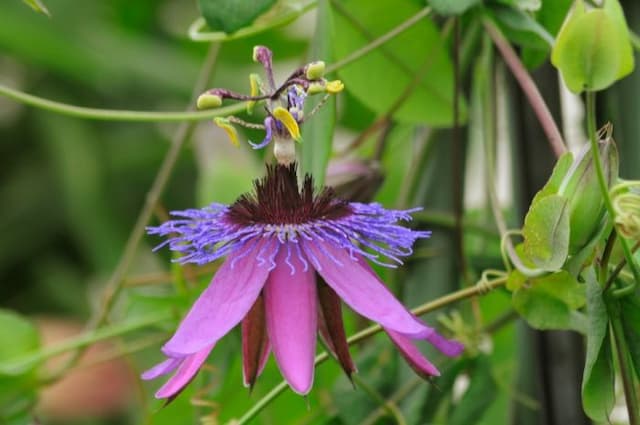Passionflower Passiflora 'Justine Lyons'

ABOUT
Passiflora 'Justine Lyons', commonly known as a type of passion flower, is a perennial vine known for its distinct and ornate flowers. The plant displays a striking array of blooms that typically feature a base color of deep purple. The flowers are characterized by their prominent, fringed coronas which exhibit vibrant tones of violet and blue, circling around a central column that includes several stamens and a style. Surrounding the central structures are five petals and an equal number of sepals which resemble petals. These sepals contribute to the overall floral display with their lush, deep purple hues that may appear almost velvety. The foliage of the passion flower is equally attractive, with leaves that are usually deep green and glossy. They are arranged alternately along the stems and are made up of three main lobes that are finely toothed and sometimes exhibit a hint of purple or red along the edges or on the undersides. The shape of the leaves can be described as broadly lanceolate, adding to the elegant outline of the plant. The tendrils of the passion flower are another distinctive feature, signifying its climbing habit as it seeks out supports to attach to for growth. These slender, coiling structures emerge from the leaf axils and allow the plant to grip onto nearby surfaces, aiding in its ability to scale structures such as trellises or fences. This particular variety, named 'Justine Lyons', may also bear fruit after successful pollination. The fruit is typically oval shaped, and its size, flavor, and color can vary, but it is often edible in passion flower species. Overall, the ‘Justine Lyons’ passion flower is celebrated for its showy blooms, climbing prowess, and lush foliage that create a visually captivating presence in a garden setting.
About this plant
 Names
NamesSynonyms
Passion Flower, Passion Vine
Common names
Passiflora 'Justine Lyons'.
 Toxicity
ToxicityTo humans
The plant in question, passionflower, is generally considered safe for human consumption when used in moderation, especially the fruits which are commonly eaten. However, other parts of the plant, such as the leaves and stems, contain compounds that can have varying effects. Ingesting significant amounts of these parts might lead to symptoms including dizziness, confusion, sedation, or ataxia. There is limited information available for the Passiflora 'Justine Lyons' hybrid specifically, so caution is advised, and it is best to avoid consuming any part of the plant not typically used for food or without professional guidance.
To pets
Passionflower toxicity in pets is generally low, but it can vary depending on the species and the amount ingested. Some pets, especially cats and dogs, might experience mild gastrointestinal upset if they consume parts of a Passiflora plant, such as vomiting or diarrhea. However, there is no widespread documentation of severe toxicity in pets for the Passiflora 'Justine Lyons' specifically. It's always recommended to prevent pets from ingesting plants not intended for them, as individual reactions can vary, and some pets might be more sensitive than others. If you suspect your pet has ingested a potentially toxic plant, contacting a veterinarian is advised.
 Characteristics
CharacteristicsLife cycle
Perennials
Foliage type
Evergreen
Color of leaves
Green
Flower color
Purple
Height
6-8 feet (1.8-2.4 meters)
Spread
3-5 feet (0.9-1.5 meters)
Plant type
Climber
Hardiness zones
9
Native area
South America
Benefits
 General Benefits
General Benefits- Ornamental beauty: Passiflora 'Justine Lyons', commonly known as Passionflower, features attractive flowers that provide aesthetic value to gardens.
- Pollinator attraction: The bloom of the Passionflower is known to attract bees, butterflies, and other pollinators, benefiting the local ecosystem.
- Shade and privacy: When grown on trellises or fences, Passionflower vines can create natural shade areas and privacy screens.
- Culinary use: Some species of Passionflower produce edible fruits known as passion fruit, which can be used in various culinary preparations.
- Cultural significance: Passionflower has various cultural meanings and is often used in symbolic or ceremonial contexts.
- Wildlife habitat: Passionflower vines can serve as a host plant for certain butterfly species, providing a habitat and food source for caterpillars.
- Easy to propagate: Passionflower can be relatively easy to propagate from cuttings, allowing gardeners to share and spread the plant.
- Drought tolerance: Once established, some varieties of Passionflower are drought-tolerant, making them suitable for xeriscaping and low-water-use gardens.
- Seasonal interest: Passionflower plants can offer seasonal interest with their cycle of flowering, fruiting, and sometimes autumn leaf color changes.
 Medical Properties
Medical Properties- Anxiolytic: Passiflora, commonly known as passionflower, is used for its sedative and calming effects, which may help alleviate anxiety.
- Sleep Aid: It has been traditionally used to promote better sleep due to its mild sedative properties.
- Antispasmodic: The constituents in passionflower may have muscle spasm-relieving effects, thus potentially aiding in conditions that involve involuntary muscle contractions.
 Air-purifying Qualities
Air-purifying QualitiesThis plant is not specifically known for air purifying qualities.
 Other Uses
Other Uses- Dye Production: The flowers, stems, and leaves of the Passionflower can be used to produce natural dyes for textiles.
- Ink Making: Juice extracted from the Passionflower's berries can be used as a natural pigment for homemade inks.
- Edible Flowers: The flowers of the Passionflower can be used to garnish salads, desserts, or to make syrups for cocktails.
- Bath Additive: Dried Passionflower petals can be added to bathwater for a fragrant and potentially soothing soak.
- Crafting: Dried flowers, leaves, and vines of the Passionflower can be used for crafting, such as in wreaths or potpourri.
- Horticultural Therapy: Maintaining and caring for Passionflower plants can be used as a form of horticultural therapy to improve mental health.
- Photography Prop: The unique appearance of the Passionflower can be used by photographers as a prop for nature photography.
- Education: Passionflowers can be used in educational settings to teach students about plant biology, pollination, and the life cycle of plants.
- Fragrance Production: The aroma of Passionflower can be infused into perfumes, soaps, and candles.
- Biodegradable Utensils: Fast-growing vines of the Passionflower have potential to be used in the manufacture of biodegradable utensils and plates.
Interesting Facts
 Feng Shui
Feng ShuiThe Passiflora is not used in Feng Shui practice.
 Zodiac Sign Compitability
Zodiac Sign CompitabilityThe Passiflora is not used in astrology practice.
 Plant Symbolism
Plant Symbolism- Passion - Passiflora, commonly known as Passion Flower, is often associated with the passion of Christ due to the structure of the flower resembling the crucifixion, hence its name.
- Sacrifice - The various parts of the flower, such as the ten petals, are thought to represent the ten apostles present at the crucifixion (excluding Peter and Judas), symbolizing loyalty and sacrifice.
- Purity - The white and blue colors of some passion flowers are symbols of purity and heaven, often related to the Virgin Mary.
- Faith - The flower’s radial filaments, which resemble a crown of thorns, can symbolize the perseverance and faith in face of suffering.
- Peace - Because of its tranquil and serene appearance, the Passion Flower is sometimes used to symbolize peace and calmness.
 Water
WaterThe Passionflower 'Justine Lyons' should be watered when the top inch of soil feels dry, typically once a week during active growth in the spring and summer. Depending on temperature and humidity, this may vary. During the dormant period in the fall and winter, reduce watering frequency to every two weeks or when the soil is noticeably dry. Provide enough water to moisten the soil evenly without leaving it soggy, about 1 to 1.5 gallons for a medium-sized plant. Always ensure that the pot has good drainage to avoid root rot.
 Light
LightPassionflower 'Justine Lyons' thrives best in full sun to partial shade. For optimal growth, place it in a spot where it can get at least 6 hours of direct sunlight per day. However, if you live in a particularly hot climate, providing some afternoon shade will help protect the plant from scorching.
 Temperature
TemperaturePassionflower 'Justine Lyons' prefers a warm climate with temperatures ranging between 60°F and 85°F. It can tolerate minimum temperatures down to 50°F but should not be subjected to frost, as this can damage or kill the plant. Ideally, keep it in a location where the temperature does not drop below 50°F.
 Pruning
PruningPruning Passionflower 'Justine Lyons' is essential to maintain plant shape, promote bushier growth, and remove dead or diseased material. Prune in early spring before new growth begins by cutting back overgrown stems and removing any dead wood. If necessary, a light trim can be done throughout the summer to keep the vine manageable. Choose the best time for major pruning after the last frost, when the plant shows new buds.
 Cleaning
CleaningAs needed
 Soil
SoilThe best soil mix for Passionflower 'Justine Lyons' is well-draining, rich in organic matter with a slightly acidic to neutral pH of 6.0 to 7.0. Combine loamy garden soil, peat, coarse sand, and compost for a nutritious and aerated foundation.
 Repotting
RepottingPassionflower 'Justine Lyons' should be repotted every 2-3 years or when the roots become visibly crowded in their current container, typically in spring or early summer.
 Humidity & Misting
Humidity & MistingPassionflower 'Justine Lyons' thrives in moderate to high humidity levels, around 40-60%, similar to its natural tropical habitat conditions.
 Suitable locations
Suitable locationsIndoor
Provide ample sunlight, trellis for support, regular watering, and humidity.
Outdoor
Plant in sun, use trellis, protect from cold, ensure good drainage.
Hardiness zone
9-11 USDA
 Life cycle
Life cyclePassiflora 'Justine Lyons', commonly known as Passion Flower, starts its life cycle as a seed, typically germinating in well-drained soil with ample warmth and moisture. After germination, the seedling emerges, developing true leaves and a root system, gradually maturing into a vigorous vine. This perennial plant experiences vegetative growth, producing complex, lobed leaves and coiling tendrils that allow it to climb on supports. The Passion Flower vine blooms in summer, exhibiting intricate purple and white flowers that attract pollinators and later develop into oval-shaped fruits if pollination is successful. The plant may enter a period of dormancy in colder climates, where it loses leaves and appears dead but will sprout again in the spring. Throughout its life, Passiflora 'Justine Lyons' can be propagated via cuttings or layering, continuing its life cycle with new genetically identical plants.
 Propogation
PropogationPropogation time
Spring-Early Summer
The Passiflora 'Justine Lyons', commonly known as Passionflower, is often propagated by semi-ripe stem cuttings. The ideal time for this method is during the late spring to midsummer when the plant is actively growing. To propagate by stem cuttings, a gardener would cut a length of stem, typically 4 to 6 inches (approximately 10 to 15 centimeters), ensuring there are at least a couple of leaf nodes present. The lower leaves are removed, and the cut end may be dipped in rooting hormone to encourage root development. The cutting is then placed in a well-draining potting mix, ensuring that at least one leaf node is buried, as roots will form from these points. The pot should be kept moist and placed in a warm, bright spot out of direct sunlight until roots have developed, which typically takes several weeks. Covering with a plastic bag can create a greenhouse effect, promoting faster root growth.









